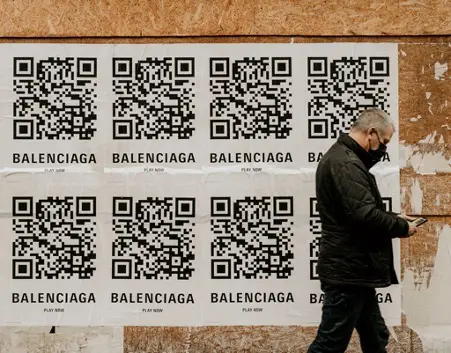We are all familiar with the standard 1D barcodes that feature throughout the retail industry. In 1974, the first UPC was scanned on a pack of Wrigley’s gum at a grocery store in Troy, Ohio. UPCs exploded in popularity from this moment, bridging the gap between the physical and digital worlds and presenting a world of information to anyone with a barcode scanner.
As technology progressed, these UPCs needed to store more data while remaining small in size. This led to the development of 2D barcodes, which now feature throughout multiple industries, from the retail world to transport and logistic labels.

What is a 2D Barcode?
A 2D barcode is a two-dimensional way to represent information. While it is similar to a linear 1D barcode, it can store significantly more data. It works by carrying information in two directions: horizontally and vertically. These barcodes are small and easy to scan.
However, they are not perfect for every application. Due to their more complex nature, compared to 1D barcodes, more powerful scanners are needed to decode the information captured in the 2D barcode. However, the popularity of 2D codes continues to grow at a rapid rate, firmly cementing itself as the future of barcode application.
Types of Barcodes
As the technology continues to develop, there is a range of widely-accepted variations of the 2D barcode.
QR Code
The QR code is the most common variation of the 2D barcode, used in various industries, from advertising and marketing to inventory management, education, tourism, and the food industry.
The information it carries includes alphanumeric text, web URLs, contact info, Wifi network details, and much more. They are not limited to black-and-white coloring and can be easily designed. Handheld optical readers and smartphone-based readers can scan these codes.
Aztec Code
An Aztec Code is primarily used in the transportation industry by major companies like Eurostar and Deutsche Bahn, mainly used for online and printed tickets. Unlike traditional barcodes, it can store alphanumeric information in far larger quantities.
While it is very similar to the QR code, it has a smaller capacity and possesses unique features in order to function correctly.
Data Matrix
Data matrix is a 2D barcode that stores text or numeric data. The most common usage is to mark smaller items like electrical components, as well as food items, beverages and pharmaceutical products.
Maxi Code
The maxi code was initially designed to be used for tracking and shipping packages. It is similar to the standard 1D barcode but uses dots instead of the traditional bars. The code includes error correction, a feature that allows it to be decoded when it is slightly damaged.
It can also be referred to as a Bird’s Eye Code or a UPS Code.
PDF417
The PDF417 format is mainly used in the aviation industry. If you have ever taken a flight, you will have seen this code feature on your boarding pass. The barcode is 17 units long and has patterns that contain four bars each.
It contains service information and features error correction codes similar to the maxi code.
2D Barcode Generators & Scanners
While retailers purchase specialised scanners to read the necessary codes on products, the general public buys millions of scanners each year in the form of smartphones. Popular models like iPhone, Blackberry, and Android have the capability to read the most commonly used 2D barcode formats.
To better understand how the design of a 2D barcode can assist scanners in reading its information, one can refer to the most popular form of these barcodes, the QR code. Firstly, it contains a finder pattern, an arrangement of squares that assist scanners in figuring out the size of the code, the direction it is facing, and the angle of the scan. Additionally, it has an alignment pattern, a squared pattern used to help scanners determine whether the code is distorted. These types of codes have a margin for error, meaning the code can be successfully scanned even with parts of it smudged or covered.
Creating your own 2D barcodes can be a complicated process, due to the amount of information that is required to properly encode them. In order to create functioning codes, appropriate and relative knowledge is needed.
However, creating a QR code is relatively straightforward, with many online code generators available to use. These generators can even be used to create QR codes that contain digital information like Microsoft Office keys, allowing for secure and convenient access to software products. They allow you to have complete control over all aspects of the process, allowing you to change everything from the format you wish to use to the size of the code itself.

2D Barcode Advertising
The introduction and application of 2D barcodes into the consumer industry greatly influenced how businesses approached their advertising campaigns with customers. Companies could add these codes to their advertisements and directly track how often the code was scanned and used.
The fashion company Tommy Bahama applied this strategy by adding a 2D barcode to their Esquire magazine advert, taking readers to the webpage of the sunglasses being shown in the magazine ad. Not only did they sell a lot more sunglasses, but they were also able to use the data to learn more about their customer’s shopping habits and the demographic of their base.
The application of these codes is most prevalent in technology-driven countries like Japan, but their growing popularity and success rate will spread their usage far and wide. Australia is another forward-thinking country which has widely embraced the usage of QR codes in the marketing, eCommerce and advertising sectors, with their popularity and functionality making them a worthwhile investment for many companies.
